DryGuard vs. AdvanTech

When it came to selecting a subfloor material, builders and contractors had limited options a few years ago. Either OSB or plywood was used. But now we are in the twenty-first century.
We have cutting-edge panels that won’t squeak at all when installed as subfloors because they can withstand swelling. These improved OSB sheathings and subfloors include DryGuard and AdvanTech.
Additionally, this article will highlight the differences and similarities between these two brands so that you can make the best decision if you are having trouble deciding between them.
DryGuard: What is it?
Georgia-Pacific Building Products produced this multi-layered OSB subfloor, which is resistant to moisture. DryGuard is not like other OSB subfloors. It was designed during production to give your floor unparalleled strength and stiffness.
DryGuard distinguishes itself from its rivals with a number of features. The DryGuard OSB subfloor has improved nail-holding properties in addition to being moisture-resistant.
A 200-day no-sand warranty is included. The manufacturer claims that the OSB floor won’t require sanding due to swelling brought on by moisture intrusion, for those of you who are unfamiliar with no-sand warranties.
This is an excellent offer that demonstrates Build GP’s strong belief in their product. Sanding OSB floors during installation takes less time and effort thanks to this warranty and feature.
There is a black edge seal on the DryGuard OSB joint floor’s edge. This seal’s objective is to stop moisture intrusion.
These boards are therefore extremely resistant to swelling. Under your carpet, DryGuard can also be used as a single-layer flooring.
DryGuard’s ability to produce a level and stable floor after installation is another noteworthy feature. The installation procedure is not too complicated. Therefore, you should think about using this subfloor material if you are a do-it-yourself builder.
DryGuard is sold at well-known big-box retailers like Home Depot. It is also available for online ordering. A limited lifetime warranty is also included.
AdvanTech: What is it?
Ultra-premium resin is used to create this superior subflooring. AdvanTech has exceptional nail-holding power, OSB strength, and—above all—moisture resistance.
High-density wood, which is incredibly strong and squeak-resistant, makes up the entire AdvanTech assembly.
The primary rival of DryGuard in the market for engineered OSB boards is AdvanTech. This material consists of a resin that is resistant to moisture, which is applied throughout the panels to prevent moisture intrusion.
It can hold fasteners quite well. Additionally, AdvanTech is very simple to install because of the tongue profile and groove. Additionally, this feature minimizes squeaking brought on by a lack of edge support and guarantees a snug fit.
Both a 500-day no-sand warranty and a limited lifetime warranty are included with this product. This indicates that they have great faith in the ability of their product to withstand moisture. The ability to lay stone or tile over AdvanTech is the best feature of this cutting-edge OSB subfloor.
AdvanTech subfloor panels are available at the Home Depot location closest to you. As an alternative, you can locate one of their representatives by going to their official website.
One of AdvanTech’s other noteworthy advantages is that it has a higher bending strength than standard OSB.
It is also much more robust and stiff. Additionally, professional builders have a great reputation for AdvanTech flooring. This suggests that it’s among the top OSB subfloors available.
Additionally, since these panels are a Huber product, you can anticipate that they will incorporate a great deal of cutting-edge technology.
Use the AdvanTech adhesive as well if you decide to use the AdvanTech subfloor. A level, steady, and silent floor is ensured by these two.
In What Ways Do They Differ?
- No-Sand Warranty Duration
There is a 200-day no-sand guarantee on DryGuard.
AdvanTech offers a no-sand guarantee for 500 days.
Building projects take time to finish, as everyone knows. This implies that for a few days, your subfloor will be exposed to moisture and the elements.
The ability of AdvanTech to withstand weather conditions for a longer period of time is the primary distinction between it and DryGuard. Specifically, by an additional thirty days.
You must make sure that your project is finished before the 200-day mark if you plan to use DryGuard. If not, the OSB will begin to swell and absorb moisture, necessitating sanding.
We can infer from this discrepancy that AdvanTech has a longer water-repelling lifespan than DryGuard.
- Favoritism Among Expert Builders
A comparison of DryGuard and AdvanTech reveals that many professional and do-it-yourself builders favor the latter brand. AdvanTech is a well-known option for OSB subfloor selection.
Many builders and contractors think it performs better and is more resistant to moisture than its counterpart.
Thus, you should choose AdvanTech if you want the most popular option among these two OSB subfloors.
What Similarities Do They Have?
- There is a moisture-resistant sealant on both subfloors.
Both subfloors are sealed to keep moisture out, even though AdvanTech can stop it from entering for a longer period. You will receive OSB sealed with a moisture-resistant resin regardless of the option you select.
- Setting up
The installation of both panels is intended to be simple. You can fit one panel after another snugly because of the length of the groove patterns and the distance between them.
- Strength of Nails
These two boards are designed to hold fasteners and nails in place for a much longer period of time. OSB floors, as opposed to carpets and tiles, are put in place with screws or fasteners rather than adhesives.
Both brands’ woods are made to make sure the nails stay in place and don’t pop out, which could compromise the stability of the floor.
- Accessibility
AdvanTech and DryGuard are readily available at a local hardware store, regardless of your preference. Both products are widely accessible and highly popular. You can also place your order online.
Benefits of DryGuard
- Outstanding resistance to moisture
- It is an OSB with high performance.
- Because it keeps moisture from leaking through, it doesn’t require sanding.
- Simple to set up
- Easily accessible
Drawbacks of DryGuard
- There is a brief no-sand warranty.
AdvanTech’s advantages
- The majority of builders and contractors choose it.
- It has superior resistance to moisture.
- A 500-day no-sand warranty is included.
- It is designed to adhere securely to nails.
- It has a lot of cutting-edge technology.
AdvanTech’s drawbacks
- Costs a little more than other OSB subfloors.
Which is superior, AdvanTech or DryGuard?
DryGuard is a cutting-edge OSB floor with many amazing features, including strength in holding nails and resistance to moisture. But AdvanTech is too strong for it.
AdvanTech is the preferred subfloor brand among many contractors for a variety of reasons. It has additional features and technology.
AdvanTech offers a no-sand warranty for 500 days. That’s three hundred days longer than DryGuard can provide.
Therefore, you should purchase AdvanTech if you anticipate that your building project will be exposed to the elements for an extended period of time. This will eliminate the need for sanding and the need to manage swelling brought on by moisture intrusion.
We cannot overlook the numerous advantages of the latter OSB panel, even though AdvanTech has superior moisture resistance.
A level, sturdy, and squeak-free floor can be produced with DryGuard. It can be carpeted and covered with various finishes. Additionally, installing it is not too difficult.
You must consider the features, benefits, and drawbacks of both of these options before choosing one. After all, there are a lot of parallels between AdvanTech and DryGuard.

